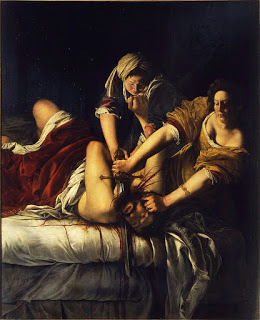
The bloody show is part of the birthing process and it might be a good subtitle for "Artemisia Gentileschi et il suo tempo" at the Museo di Roma which deals with the career one of the great woman artists of all time. Artemisia might not have been " "untimely ripped" from her "mother's womb" but there are heads everywhere in the iconography of the world in which she would eventually make her mark. Her father Orazio was a noted painter in his own right who did "David Contemplating the Head of Goliath" (1610-12). Nicholas Regnier would take on the same subject (1625-6). Artemesia painted "Judith Slaying Holofernes" (1614-20) as did Cristophano Allori (1620) and Bartolomeo Manfredi (1618-20). Giovanni Baglione did "Herod, Herodias and Salome With the Head of John the Baptist" (1615-20). It was a heady time, filled with both violence (Artemisia had been raped by the painter Agostina Tassi) and beauty. The influence of Caravaggio is unmistakeable; in fact Artemisia painted her Judith the year of his death. But heads were not all that was cut. The exhibition includes Simon Vouet's "The Circumcision" (1620) and Mario Balassi's "Ghismonda Receiving Guiscardo's Heart" (1635). However, it's important to remember that that this was also a period in which the humanistic spirit soared to great new heights. Cosimo II di Medici was one of Artemesia's patrons and it was at his court that Artemisia met Galileo. Paintings with titles like "Time Reveals Truth and Unmasks Deception" and "Intelligence, Memory and Will" (1624) are noteworthy. The painter Crisofano Allori was also the author of "The Poetics of Affection." Roland Barthes is quoted thusly by the curators,
"The strength of Gentileschi's paintings lies in the brusque reversal of roles. It is informed by a new ideology, which we moderns received already: the vindication of women."
{This was originally posted to The Screaming Pope, Francis Levy's blog of rants and reactions to contemporary politics, art and culture}
Judith Slaying Holofernes by Artemisia Gentileschi